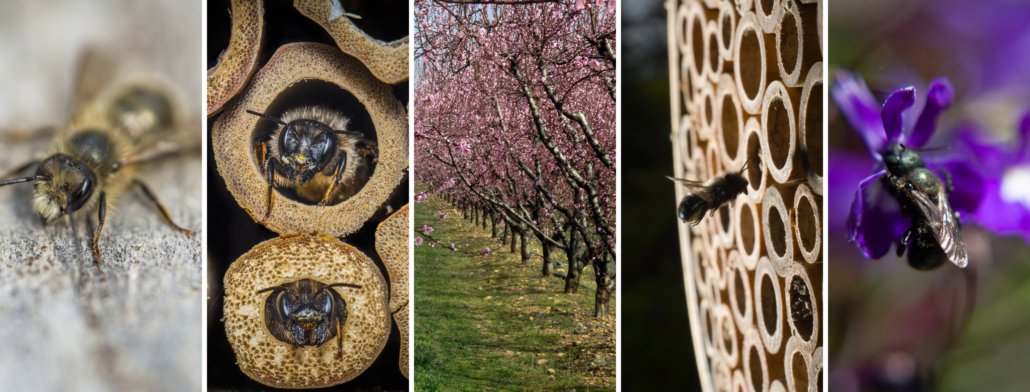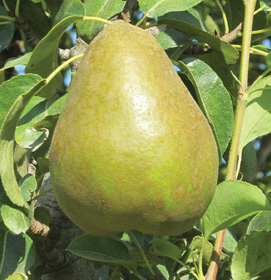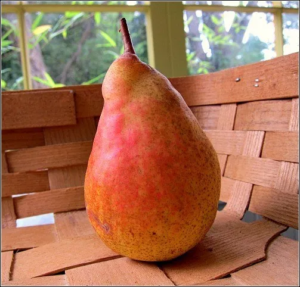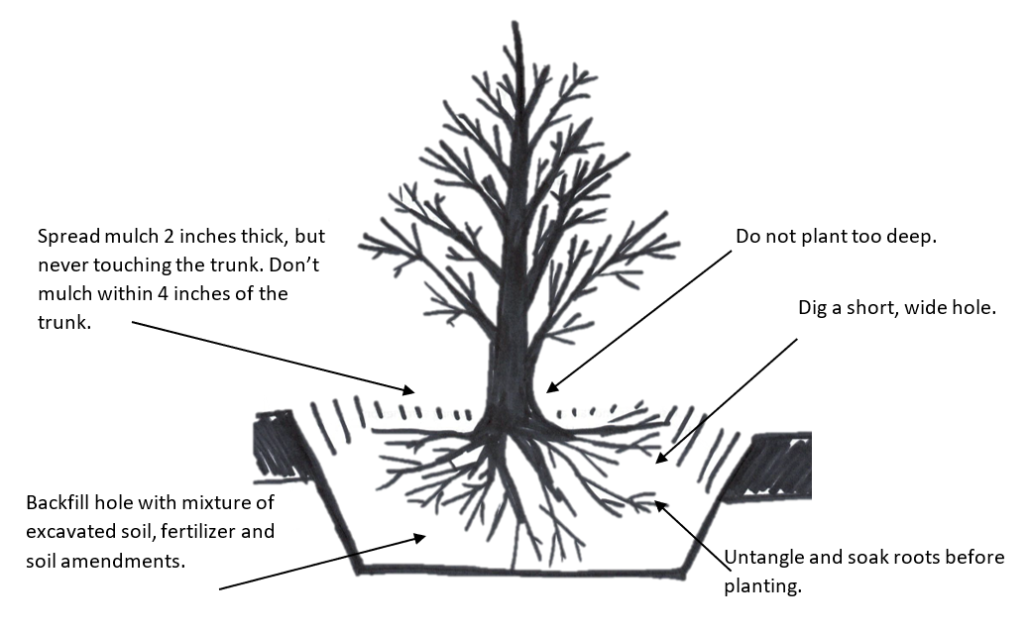** Apples require another apple or crabapple variety in order to produce fruit. All of our apple trees are grown on semi-dwarf rootstock in order to accommodate most home orchards, unless otherwise noted.
Ashmead’s Kernel (Dwarf)
An old English heritage apple with a very distinct, sweet-tart flavor. The greenish brown russetted fruit is not pretty, but is highly aromatic and considered to be one of the best eating apples in history. Great for ciders and cooking as well. An excellent keeper apple. Ripens in October and has good disease resistance. Pollinate with any other apple on this list except Gravenstein. A WSU Mt. Vernon recommended variety.
Beni Shogun Fuji
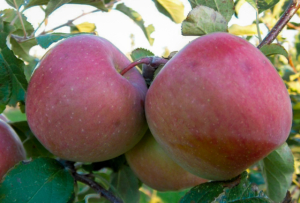
This mutation was found in Japan in 1992. It is a heritage variety and ripens earliest of all Fujis. This is a wonderful choice for organic growers; it is scab and mildew resistant. It has an orange-red skin and is medium to large sized. Ripens in mid-October. Juicy sweet flavor with a distinctive aroma. Excellent for eating, cider, and stores well.
Braeburn
Developed in New Zealand in the 1950s the Braeburn has become one of the most important apple varieties in production. It makes an excellent dessert apple with a crisp texture and very juicy. The flavor is described as sweet without being sugary, sharp and refreshing. It was one of the first bi-colored varieties created with shades of red and green. WSU Mt. Vernon recommended variety for the Puget Sound.
Chehalis
This old favorite was discovered north of Chehalis WA in 1937. This is a large, sweet yellow apple that resembles Golden Delicious in looks and flavor but it is crisper and larger. This is a reliable, highly productive tree well suited for organic growers; it is highly resistant to scab and has good mildew resistance. Fruit ripens in September. Great for fresh eating and for baking and saucing. Semi dwarf.
Cosmic Crisp (Dwarf available)
An exciting new variety of apple developed by Washington State University, released in 2019. Mid to late season bloom, ripens in early October. The flavor is exceptional, both sweet and tart, making it an excellent apple for fresh eating. In addition to excellent flavor it is slow to brown once cut and holds its flavor for more than a year in storage! The apple is red in color with yellow flecks on the skin. Its name came from those attractive speckles, which look like stardust (Cosmic) and the apple has a unique crisp texture, giving its name of ‘Cosmic Crisp.’ Semi dwarf and M27.
Enterprise (Dwarf)
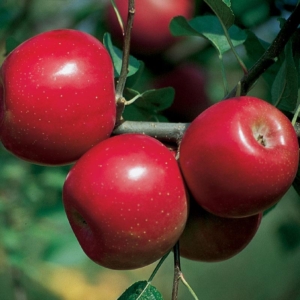
This versatile apple started out in 1982 as a seedling and was released to market in 1993. This deep maroon apple is mildly tart and spicy, it is good for eating right off the tree, but where it really shines is in the kitchen. Its flavor improves after storage and can be stored for up to six months. This variety is very disease resistant and ripens in early October.
Gala
The most popular apple in the world, the Gala was bred by horticulturist J.H. Kidd in New Zealand circa 1934, but it wasn’t introduced to the US until the 1970s! It is a cross between Golden Delicious and one of his earlier varieties, Kidd’s Orange Red. Gala boasts a sweet flavor with hints of vanilla and has a floral aroma. The skin has a pale golden yellow background covered by a stripy red blush. Juicy and sweet with a crisp texture, this is a great multi-purpose apple suited for both fresh eating and cooking, but not for storing. Gala apples make excellent juice! Early bloomer, early to ripen. Semi dwarf.
Gravenstein
This nostalgic cultivar was the primary variety during WWII to make apple sauce and dried apples to feed the troops. The skin is a delicate waxy yellow-green with crimson spots and reddish lines. The flesh is juicy, finely grained, and light yellow. It is a triploid variety which means it is a poor pollinator of other apples. One of the best cooking apples but sadly not suited for storage, which is why it is seldom found in markets. An early to mid season bloomer that is one of the first apples to ripen. Semi-dwarf.
Honeycrisp (Dwarf available)
A modern apple with perhaps the best eating qualities in history. Medium to large red blushed with yellow apples are highly aromatic. Explosively crisp, sweet and juicy, yet with some tartness. Excellent for fresh eating, or for pies, crisps and sauces. Fruit ripens in late September but becomes more flavorful if left on the tree into October. A good keeper apple. Good disease resistance. Pollinate with any other apple variety on this list except Gravenstein. A WSU Mt. Vernon recommended variety. Semi dwarf and M27.
King, aka Tompkins King, or King of Tomkins County
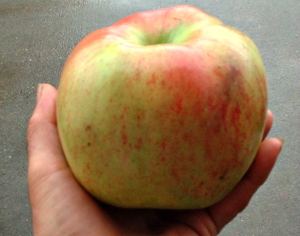
This historic variety has been known since 1804. Large, waxy yellow-green background with red striping and blushing. Crisp and sweet, they are excellent for fresh eating, as well as cidering and cooking. Will keep 2-3 months. Bears mid-to-late Oct. This highly prized apple is a tip bearer: wait to prune until two inches of new growth has begun in spring. Then prune back to 6-8′ of last years growth! This variety is a triploid and is pollen sterile. It will not pollinize other varieties.
Liberty
One of the easiest apples to grow and should be included in all Whidbey orchards. It produces a bounty of medium sized, shiny red, aromatic apples with yellow overtones. Very juicy apples with crisp white flesh, and a sweet, crunchy texture. Good for fresh eating, baking and ciders. Ripens in late September and stores well. Very disease resistant. The tree tends to over-produce; thinning produces better quality fruit. Pollinate with any other apple variety on this list except Gravenstein. A WSU Mt. Vernon recommended variety.
Melrose
Developed during WWII in Ohio, the Melrose is considered a modern apple. It is a cross between Jonathan and Red Delicious. The result is flattened large fruit, whose skin is streaked and flushed with dark red over a background of yellowish-green skin, with spots of russet. The flesh is creamy white, firm, coarse-textured, and juicy. The flavor is mildly acidic, similar to Jonathan, but not as tart. It is top-rated for reliability. Often used for baking, Melrose is a great keeper apple whose flavor often improves with storage. Ripens in October, Semi dwarf.
Mutsu
Also known as Crispin. Sweet, honeyed flavor – good for eating, baking, and cider! Cross between Golden Delicious and Indo. Its large fruit is green/yellow. Highly resistant to frost injury. Ripens end of September. Some disease susceptibility, does not pollinate other trees, tends toward biennial production.
Pink Pearl
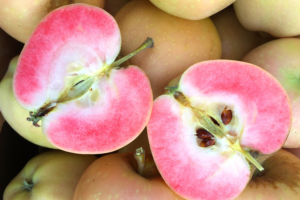
Flavorful, aromatic yellow apple with with BRIGHT PINK flesh! Use it to make a beautiful pink applesauce or to add color to fruit salads. Although the tree is susceptible to scab, we have found that it is worth growing anyway. Ripens in late September.
Sunrise Magic
First apple released by WSU a cross between Splendour and Gala. Pinkish-red blush over a yellow background, with firm, crisp and juicy flesh. Great fresh off the tree and stores well too. Ripens late Sept/early Oct.
Espalier: A 3-tiered fruit tree with 3 different kinds of apple varieties grafted to one root stock:
- Espalier 1- Gala, Honeycrisp, Fuji
- Espalier 2- Akane, Honeycrisp, Liberty
*Apples require another apple or crabapple variety in order to produce fruit.
Need to know which trees pollinize which? Check out these Pollination Charts from Biringer Nursery.
